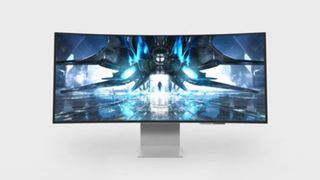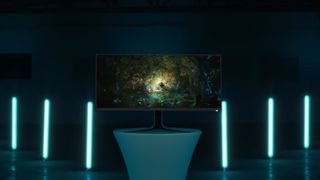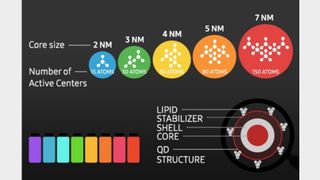Quantum Dot OLED gaming monitors aren't just sci-fi nonsense, they're the future
QD-OLED is set to bring incredible colour, contrast and response times to the world of gaming monitors.

QD-OLED, or Quantum Dot organic light emitting diodes if you're feeling fancy, sounds to me like something Spielberg invented for his latest sci-fi installment. But after some delving, it's actually looking to be one of the most interesting innovations we've seen in the gaming monitor space of recent, bendable screens aside of course.
Samsung just rolled up at CES 2022 with the Odyssey G8QNB gaming monitor, with its 175Hz refresh, vivid colours, and ultrawide 1440P, curved design. But what I'm most excited about is the fact it works on QD-OLED display technology.

It's touting same panel tech behind the new Alienware AW3423DW, also unveiled during the chaos of CES. For that reason, both technically hold the title of world's first Quantum Dot OLED gaming monitor. But, I guess it depends which one comes to market first.
Either way, we've been exploring what makes the science behind this innovative panel so exciting.
Now, the Quantum Dot concept has been around for a while, being used in QLED TVs and the like, but it's the combination of Quantum Dot and OLED tech that makes this design interesting.
OLED tech is impressive by itself, offering better contrast with darker blacks, thanks to its ability to switch LEDs off completely in the dark spaces of your image without any blooming. QD-OLED, however, takes things to another level, combining the contrast levels of OLED with bright and vibrant Quantum Dot tech.
For Quantum Dot panels, engineers make use of something affectionately dubbed 'the sandwich.'
The biggest gaming news, reviews and hardware deals
Keep up to date with the most important stories and the best deals, as picked by the PC Gamer team.

Samsung explains that its manufacturers add nanoparticles to layers of film, glass and filters within the panel. It's like sprinkling sesame seeds in between all the layers of your sandwich, except they're only visible under a microscope, and they emit different colours when you shine certain light frequencies through them.
Also, they're not seeds at all, they're particles with "semiconductor properties," which vary in size depending on the colour they're meant to emit. "Larger dots emit light that is skewed toward red, and progressively smaller dots emit light that is skewed more toward green," the insights post elaborates.

Best microphone for gaming: make sure you're heard
Best webcams: be seen while you get your stream on
Best capture cards: lessen the load with a dedicated card
In combining the supreme colour gamuts of the QD tech, with organic, self emitting, blue lighting beneath it, you get something truly exciting. And apparently it's better for your eyes thanks to its optimised blue light exposure. Samsung has even boiled down the once convoluted structure of the LCD Quantum Dot tech to include fewer layers too, meaning the panels can be much thinner than before.
For gaming, this tech even promises faster response times, at true 0.1ms G-t-G, and better HDR. But I suppose we'll discover all this first hand when we get a chance to test one.
Well, now I'm feeling both excited for the future of gaming monitors, and a little bit hungry for sammiches. Cheers Samsung.

Screw sports, Katie would rather watch Intel, AMD and Nvidia go at it. Having been obsessed with computers and graphics for three long decades, she took Game Art and Design up to Masters level at uni, and has been rambling about games, tech and science—rather sarcastically—for four years since. She can be found admiring technological advancements, scrambling for scintillating Raspberry Pi projects, preaching cybersecurity awareness, sighing over semiconductors, and gawping at the latest GPU upgrades. Right now she's waiting patiently for her chance to upload her consciousness into the cloud.
Most Popular





